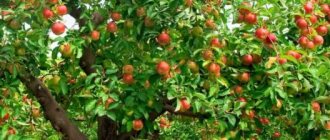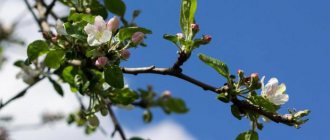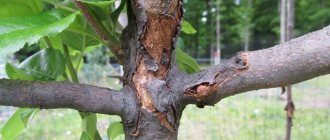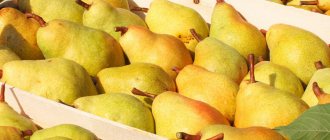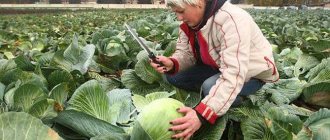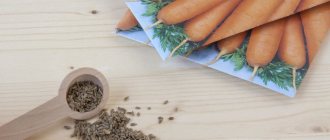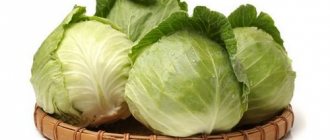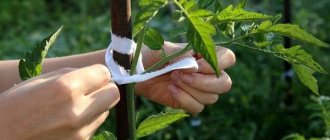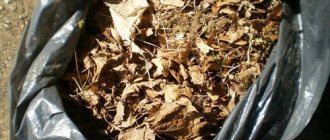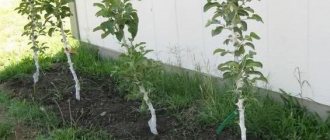Chemical removal of stumps (butt and rhizome) is based on processes that occur in wood under the influence of various reagents.
Exposure to the correct reagent not only kills all wood, including even not too large roots, but also destroys all pathogens of the trunk and roots.
Moreover, each of the methods has one or another negative effect on the soil , so the method of chemical exposure must be chosen taking into account this effect in order to minimize the harm for the subsequent use of this piece of land.
Unfortunately, chemical exposure cannot destroy the stump and root system, which means the dead wood will need to be burned or removed.
Therefore, chemical exposure is most often used to combat pathogens and in cases where it is necessary not only to pull out the butt with roots, but also to prevent the germination of remnants of the root system.
More information on how to remove tree stumps using various methods, including uprooting and burning, can be found here.
When is such tree stump removal justified?
As a result of the removal of wood by chemicals without uprooting, aggressive substances enter the soil , which negatively affect many plants.
Some of these substances can be neutralized in various ways, making the soil suitable for planting, but if construction is planned on the cleared area, then these substances will not affect the properties of the soil in any way.
Therefore, it is worth using chemical destruction and stump removal only if the side effects will not in any way affect the further use of the land or they can be neutralized.
Chemical uprooting is most effective for wild trees and trees located near buildings. Many wild species are distinguished by their tenacity, so even after mechanical removal of most of the root, shoots emerge and continue to grow.
Using the right drugs, you can completely stop their growth and destroy most of the root system, after which the area can be used in any way.
Chemical uprooting is also most effective in relation to the root system of diseased trees. The thing is that the pathogens infect groundwater, which can lead to an epidemic among other plants.
Mechanical or manual uprooting does not remove all roots , and it is not always possible to burn out the remains, so the only reliable way to combat such diseases is chemical destruction of the roots. You will learn further about how exactly you can remove stumps and roots using chemical methods.
How to do something yourself, with your own hands - home craftsman website
There can be many reasons why it is time to uproot a tree - for example, improper pruning, after which the fruit tree in the garden stopped bearing fruit (to prevent this from happening, read our article: How to properly prune trees in the garden), maybe the tree has outgrown its lifespan fruiting and became old, withered from heat or damage by pests, withered in the shade of another large tree from lack of sun.
If you do not have sufficient experience in uprooting trees, you can deal with the stump remaining after pruning for more than one week.
Let's say right away that different trees are uprooted in different ways - some faster, others longer - it all depends on the root system. Of course, it is faster to uproot a bush than, for example, an old cherry tree or a stump left from a birch tree that remembers King Pea.
Using the example of uprooting stumps from two apple trees, we will give an example of how you can uproot a garden tree as quickly as possible and with the least loss of strength.
TOOLS FOR HOME AND GARDEN, HANDCRAFTS, ETC. PRICES VERY LOW
We had to uproot two apple trees, one of which grew on a slope, and the other on level ground. The diameter of the trunks near the ground was approximately 35-40 cm.
Previously, the trees were pruned, leaving a large shoulder of the trunk so that it was easy to swing it and cut off the deep-lying roots. The stump turned out to be quite tall. For the work you needed a sharp, narrow garden saw, pruning shears, a shovel and a bucket.
First, they excavated a tree-trunk circle with a diameter of about 1.5 meters to the depth of a spade bayonet. Then they washed away the ground in this circle with a stream of water from a hose.
On the slope, the water along with the soil left the hole by gravity, through a pre-dug ditch. Out of the blue, the water and soil had to be scooped out with a bucket. The roots were quickly exposed, and further work was not carried out blindly.
The roots were cut with a saw, making two cuts on each. Thus, logs 5-10 centimeters long were cut out so that when swaying, the roots would not spring or rest. Gradually, all the lateral roots of the tree were cut out in this way, and the central ones, going deep down, were torn when rocking.
Without heavy physical effort, the apple tree that grew on the slope was uprooted in two hours, and the one on level ground was uprooted in four hours.
Popular drugs and their uses
Here is a list of the most popular reagents that are used to destroy stumps and root systems of trees:
- saltpeter and urea;
- copper or iron sulfate;
- salt.
Saltpeter and urea
These reagents (potassium and ammonium nitrate, as well as urea) are used where it is possible to burn the stump after treatment.
After all, they do not destroy the wood, but sharply increase its flammability , which is why even the roots burst into flames from a small fire.
To introduce them, holes with a diameter of 10–50 mm are drilled; the location of the holes depends on the method of tree removal.
On sawn stumps, drill vertically, evenly distributing holes along the cut; on broken stumps, drill the trunk, placing holes around the entire perimeter.
The distances between the holes are 5-10 cm . If the barrel is drilled from the outside, then the drill is directed at an angle of 20–40 degrees so that the reagent does not spill out.
Any type of saltpeter or urea is poured into the prepared holes (no need to mix them together) to the top, then watered a little so that the granules settle, and the holes are closed with a wooden, clay or plasticine stopper.
A wooden plug is made from a thick branch with a knife so that it fits 1–2 mm into the hole with noticeable force. Then it is inserted into the hole filled with the reagent and hammered in with a hammer so that it sinks 1–2 cm. The protruding remains of branches are not cut off so as not to loosen the plug.
A clay plug can be made from clay or the surface layer of the earth; for this, the soil is crushed and a little water is added.
The amount of water is determined experimentally - after thorough mixing, the consistency of the clay should be similar to a very thick dough or not very hard plasticine.
Clay is placed in the hole until it is filled and compacted with a finger, gradually adding more. Plasticine cork is made in the same way, only plasticine is used instead of clay.
After 1–2 years, the roots are dug up and a small fire is laid around the trunk .
If you don’t know how to dig up roots, we recommend reading the article Manual uprooting.
Then the fire is set on fire and care is taken to ensure that the fire from the burning stump does not spread to neighboring trees, buildings or grass.
While the stump soaked in reagents is “ripening,” the soil around it is filled with nitrogen-containing substances , so it is advisable to plant any fruit plants at a distance of 4–5 meters from it. This distance is enough to reduce the amount of nitrates to a safe level.
After burning the stump, the hole is filled with old and new soil, then inedible plants are planted, producing a large volume of green mass. In the fall, all greens collected from the plant must be burned in order to completely utilize nitrogen compounds unsuitable for plants and people.
Next year the site is ready to accept any plants. If construction work is planned at this place, then it can begin immediately after the pit has cooled.
This method is ineffective against diseases of plants with a widely branched root system , because the reagents will not harm pathogens located noticeably below the combustion zone. In addition, it cannot be used on peaty soils, because a burning stump will set the peat on fire, and an underground fire will start, which is very difficult to extinguish.
Copper or iron sulfate
Both substances are very toxic and kill any bacteria living in wood, so they are used to disinfect the roots of diseased trees. The preparations are applied in the same way as saltpeter, only the holes are made with a diameter of 5–8 mm and a depth of 5–10 cm.
Suppression of the vital activity of the root begins within a few days, but complete death of the wood occurs after 1–2 years. After the wood dies, the roots must be dug up and uprooted in any way or, surrounded with firewood, burned.
These reagents cannot be used near metal pipes , as they will dramatically intensify all corrosion processes.
In addition, within a radius of 3–5 meters, the content of these substances will increase, which will negatively affect the vital activity of microorganisms involved in soil restoration, so any plants will grow poorly there for several years .
If the roots were not removed but burned, then this period will increase to tens of years. If the roots are uprooted, then after 2-3 years the level of these substances will decrease, after which the soil will gradually recover.
Salt
In 1–2 months, this reagent that live in them. They are added in the same way as both types of vitriol.
If the area around the tree is planned to be used as a road or concrete-filled area, then after it dies, the stump and roots can be burned. In all other cases, they need to be uprooted, otherwise excess salt will make the soil infertile for decades, and any iron product will quickly rust.
Traditional methods
Such methods are rarely used, but they give results:
- Use of water. If the wood is rotten, then in the fall it is filled with water. In winter, the liquid freezes and the tree collapses. In the spring, pulling out a stump is not difficult.
- Planting mushrooms. In the fall, cuts are made in the tree, into which spores of honey mushrooms or oyster mushrooms are poured. The film is placed on top. By next autumn, mushrooms will grow. After 5 years the stump is destroyed.
- Machine oil. In the spring, the earth is dug around the trunk to a depth of 15 cm. The bark is removed and the tree is doused with machine oil. Then the bark is applied back. Green shoots will begin to grow first, but by mid-summer they will wither. After a few years, the wood will deteriorate.
If in a summer cottage there is a need to uproot stumps, then this issue is not a difficult one. If you have time, you should use chemicals, and in 5 years the wood will be destroyed. If the work is urgent, you can order special equipment or do the removal procedure yourself.
When is the best time to carry out treatment?
If there is rot in a broken tree, or the roots are affected by some kind of disease, then vitriol or salt can be added at any time of the year , because the first place is to fight the disease and prevent tree epidemics.
If there is no urgency, then it is advisable to apply all types of reagents after the end of the autumn rainy season , 1–3 weeks before the onset of frost.
During this time, the reagents will penetrate below the soil level and will saturate the wood even during frosts. In addition, the absence of rain will not lead to leaching of the reagent and a decrease in its effectiveness.
How to prune an old apple tree
Temperature parameters in March should be quite warm and not fall below -10C; Inspect the tree for damaged and broken branches and remove them; For apple trees older than seven years, branches are first removed from the top of the crown, then the middle and lower ones; Dry, non-fruiting branches should also be removed; All damaged branches are removed to the living area and must be treated with a sanitary garden varnish; Make the tree height no higher than 4.5 m for ease of chemical treatment and harvesting
Try on your own stepladder; After removing old and damaged branches, pay attention to the annual growth facing upward towards the trunk. Such branches are not viable - they cannot bear the weight of the fruit, they should be removed, like branches growing downwards.
Security measures
Ammonium and potassium nitrate are explosive flammable substances, so they must be used with extreme caution.
Do not smoke while working with them. 1–3 months after the laying of nitrate, active processes occur in the wood associated with the release of flammable gases, so you should not smoke or light a fire near a stump treated with these reagents.
Copper and iron sulfate in a dry state are safe for human skin, but when working with them you must use a respirator, goggles and gloves.
After all, after adding water, the vitriol crystals will quickly turn into a toxic liquid that can burn the skin. Contact of crystals and drops on mucous parts of the body is especially dangerous.
Table salt is safe in its dry state and takes a long time to dissolve in water. When working with coarse salt, no safety precautions are required , but when working with fine salt, you need to use glasses, because an unexpected gust of wind can blow it into your eye.
To reduce the risk of fire when burning a stump and roots, it is necessary to pour a circular earthen bank ≥50 cm high around the pit. Burning wood should not be left unattended, because it can shoot quite large sparks that fly 5–10 meters and go out only after a few minutes.
In addition, you should always have a fire extinguisher on hand and, preferably, a hose connected to the water supply - this will help extinguish an incipient fire far from the stump.
You should not stand on the leeward side of burning wood, because it, impregnated with saltpeter or urea, releases toxic substances when burned.
In addition, it is advisable to obtain permission from the nearest department of the Ministry of Emergency Situations to burn the stump, otherwise a large fine may be issued. You will find more information on this issue in this article (Combustion).
Do not use other substances for chemical exposure, especially those based on glyphosate (Roundup, Typhoon, Santi). They effectively kill wood, but do not decompose in the ground, so they first enter new plants, then with their fruits into the human body.
The most read on the LandshaftBlog.Ru website:
Brick barbecue Gazebo with barbecue Concrete paths Landscaping Choosing a brush cutter Geogrid Guzmania Ornamental grass Decorative flower beds Decorative fence Children's slide Garden design Firewood for the dacha Mesh fence Winter garden Ideas for the dacha Flower bed made of stones Flower beds of perennials Lianas for the garden Polycarbonate awnings Site lighting Greenhouse do-it-yourself sandbox Do-it-yourself area for a car Retaining wall Facade lighting Swing gates Garden arch Garden fountains Snow shovel Brick tandoor Topiary in the garden Thuja occidentalis Plot 15 acres Figures for the garden Coniferous plants
Burning a stump
If others do not mind, the stump can be burned down. Holes are drilled in it, lighter fluid or kerosene (not gasoline) is poured in, a cotton wick is inserted and a match is placed. Monitoring the process and timely removal of burnt wood is required. By the end of the process, the useless element will become useful fertilizer - wood ash.
Uprooting
This method is one of the most common. If the tree that was cut down was young, or it was a bush, uprooting the stump will not be difficult. It needs to be dug in from all sides and pulled out.
If some shoots turn out to be too long and grow deeper, they need to be cut off from the base of the stump and later dug up separately.
Uprooting the stump of an old tree alone is very difficult. It will also have to be dug in. Imagine how long it takes one person just at this stage.
So, you need to dig up the stump, exposing the roots as much as possible. That is, you will have to dig under them so that they appear as if on a canopy. After this, you can saw them off or chop them off the trunk. If it is not free, then another, strongest root is going down. The stump will have to be loosened.
Perhaps a saw will not do here either. When the stem part is separated from the roots, each of them must be dug up separately.
As you can see, this method is very labor-intensive. But is it really impossible in the 19th century to remove without uprooting? Perhaps, even in several ways.
Functional approach
If the time factor for summer residents is not of decisive importance, and environmentally friendly creative ideas for landscaping the site are overwhelming, then alternative methods of destroying stumps without the help of chemicals will do a good deed and lift your spirits.
Stumps can serve as an excellent material for making original “designer” furniture in the garden
In skillful hands, woody remains are transformed into landscape decorations in the form of sculptures, flower vases, all sorts of intricate tables, benches and other unexpected things pleasing to the eye.
In addition, to reap maximum benefits, some gardeners use large tree stumps as a growing medium for growing mushrooms. During the period from April to June, cuts about 5 cm deep at a distance of 10-15 cm from each other are made on the remains of freshly cut deciduous trees (for example, hornbeam or birch). The mycelium, already germinated on the substrate, is placed in them, and the sown area is tied with film. Fruiting with the ability to harvest fresh mushrooms lasts from 30 to 50 days, depending on the weather.
Cultivation of oyster mushrooms or honey mushrooms can continue for several (5-6) years; the mycelium eventually destroys the stump without any uprooting
Fruit tree stumps are suitable for growing flowers. To prepare a flower bed, make a neat hollow in the center or select a core. Then drainage is laid, several inclined holes are drilled to drain water, and the wood is treated with an antiseptic primer or simply painted. Fill with soil, add sand and gravel and sow flowers directly into the ground or plant ready-made seedlings of annuals, for example, violets, periwinkle, petunias.
Petunias in a makeshift flowerbed in the garden
Milling
Milling is one of the methods that allows you to quickly uproot a stump, suitable for both large plots of land and small areas. For this purpose, a milling or crushing plant is used.
Removing interference in this way has the following advantages:
- No preparation is required to import and install the machine. There is no need to dig under the roots or make cuts.
- A fabric tent will protect the rest of the area from clogging with sawdust and wood chips.
- The operator controls the installation, working quickly and accurately.
- the need to purchase or rent equipment;
- impossibility of removing roots deeper than 30 cm;
- the installation cannot be used on rocky or cluttered terrain due to the risk of damage to the cutter;
- The machine is not recommended to be used for removing the remains of hardwood trees due to the rapid wear of the replaceable element.
After removing the trunk, there remains a neat depression and a pile of wood chips used for heating or mulching the soil.
Uprooting with a tractor
The technology makes garden cleaning easier and faster. The tractor is equipped with a special attachment. Clears the garden of several stumps at once. Free space is required to turn the equipment.
The stump is tied with a cable and pulled out of the soil. Large stumps require a heavy-duty crawler tractor that will leave a deep mark on the area.
Advantages:
- Pulling out multiple stumps at once reduces the cost of removing a single stump.
- New trees are planted in the resulting holes.
Flaws:
- A massive tractor destroys lawns and garden paths.
- The stump leaves a large hole that may need to be filled in with soil.
Grinding
The stump is crushed using a specialized machine – a chopper. After the equipment passes, the soil crushed to a given depth along with the stump remains.
Advantages:
- The operator controls the work.
- The machine removes any stumps.
Flaws:
- The mechanism will break if it hits rocks.
- The maximum treatment depth is 30 cm. Additional root removal will be required at a depth of more than 30 cm.
Winch
Clearing the area using a winch makes it possible to use the apple tree for replanting:
- the soil under the tree is moistened abundantly;
- dig a hole around the tree trunk;
- open the roots and remove;
- The tree trunk is tilted to the side using a winch;
- cut off the remaining stretched roots;
- the tree is pulled out.
When working, follow safety precautions.
